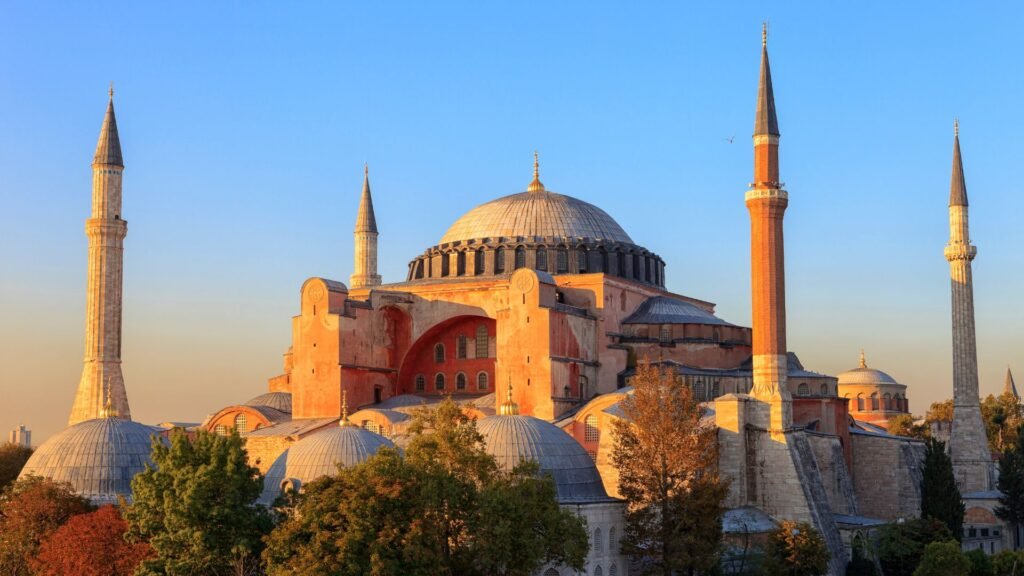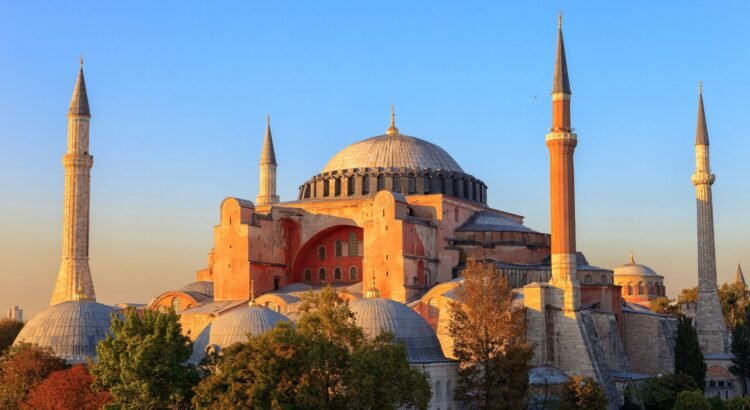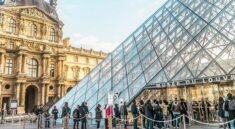
Rising at the crossroads of continents, cultures, and civilizations, Hagia Sophia—or Ayasofya in Turkish—stands as one of the world’s most enduring architectural marvels. Towering over the heart of Istanbul, this majestic structure has, for nearly 1,500 years, served as a symbol of power, faith, art, and resilience. Once a grand Byzantine cathedral, later transformed into an imperial mosque, and eventually reimagined as a museum and, again, a mosque in recent years, Hagia Sophia’s complex story mirrors the layered and ever-evolving identity of the city itself.
From the grandeur of its soaring dome to the delicate details of its Byzantine mosaics and Ottoman calligraphy, Hagia Sophia is not just a building—it is a living archive of empires, beliefs, and the beauty that emerges when they intersect. To explore Hagia Sophia is to journey through the very soul of Istanbul, where East meets West, and where stone speaks louder than centuries of silence.
A Legacy Born in the Byzantine Empire
Hagia Sophia’s story begins in 537 AD, under the reign of the Byzantine Emperor Justinian I, who envisioned a church unlike any other in Christendom. The emperor famously declared, “Solomon, I have surpassed thee,” upon seeing the completed structure—an ambitious testament to both his faith and imperial power.
Constructed in just five years, the building was a triumph of ancient engineering. Architects Anthemius of Tralles and Isidore of Miletus designed a massive basilica crowned with a dome over 100 feet in diameter, resting seemingly weightless atop four massive piers. At the time, it was the largest enclosed space in the world, and it remained the largest cathedral for almost a millennium.
Inside, shimmering mosaics of Christ, the Virgin Mary, and various saints adorned the walls and ceilings. Sunlight filtered through rows of arched windows, casting golden glows across marble floors and vast galleries. Hagia Sophia became the centerpiece of Orthodox Christianity, hosting imperial coronations and the Eastern Roman Church’s most sacred rites.
For nearly 1,000 years, it was the spiritual heart of the Byzantine world.
From Cross to Crescent: The Ottoman Transformation
In 1453, a pivotal moment arrived that would forever alter Hagia Sophia’s identity. The city of Constantinople fell to Sultan Mehmed II, marking the end of the Byzantine Empire and the rise of the Ottoman Empire. Rather than destroy the cathedral, Mehmed the Conqueror chose to preserve and transform it into an imperial mosque.
In a striking gesture of continuity and change, Islamic elements were delicately added over time:
- Mihrab, minbar, and minarets were installed.
- Byzantine mosaics were either covered or preserved beneath plaster.
- Giant calligraphic medallions with the names of Allah, Muhammad, and the four Caliphs were hung alongside angelic figures.
Under the Ottomans, Hagia Sophia became the symbolic and spiritual center of the empire—Friday prayers, royal announcements, and public ceremonies were conducted here. Architects like Mimar Sinan, the empire’s most famous builder, even reinforced the structure with buttresses, ensuring its longevity.
For over 480 years, Hagia Sophia stood as one of the world’s most significant mosques.
A Museum for the Modern World
In 1935, after the fall of the Ottoman Empire and the establishment of the secular Turkish Republic under Mustafa Kemal Atatürk, Hagia Sophia entered a new chapter—as a museum open to all.
This transformation was symbolic. It was a move toward pluralism, secularism, and cultural preservation. For the first time in centuries, both Christian mosaics and Islamic features were visible, offering visitors an unmatched experience of shared history.
People from around the world came to marvel at its dual legacy:
- Tourists, historians, pilgrims, and artists walked the same marble floors trodden by emperors and sultans.
- Scholars studied the Byzantine mosaics, including the Deësis panel, considered one of the greatest artistic achievements of the Middle Ages.
- Visitors paused in awe beneath the vast dome, imagining the ancient chants and calls to prayer that once echoed within its sacred walls.
For nearly a century, Hagia Sophia became a beacon of coexistence, a place where cultural and religious narratives coexisted under a single roof.
Back to a Mosque in the 21st Century
In 2020, another historical shift occurred. The Turkish government reclassified Hagia Sophia as a mosque once again, with Muslim prayers resumed inside the building.
Despite global debate, the transition was framed as a return to heritage, especially for many Turks who saw the site’s Islamic identity as a key part of national history. However, in a gesture toward continuity and inclusion, the government pledged to keep the structure open to tourists, and Christian mosaics remain uncovered outside of prayer hours.
Today, Hagia Sophia is a living monument—a mosque, yes, but still functioning as a museum of the world, welcoming millions of visitors annually.
Architectural Genius: Dome, Light, and Harmony
Hagia Sophia’s architectural significance cannot be overstated. At the heart of its brilliance is the central dome, which appears to float like a celestial canopy. Supported by pendentives, it was a revolutionary design for its time and influenced centuries of religious architecture across both the Islamic and Christian worlds.
Other standout elements include:
- The Omphalion, where Byzantine emperors were crowned, adorned with intricate inlays of porphyry and marble.
- The Upper Gallery, once reserved for imperial families, offering a panoramic view of the nave and the dome’s underside.
- The marble marquetry—walls clad in polished stone from quarries across the empire, forming stunning symmetrical patterns.
- The massive wooden doors, believed to be over 1,400 years old, made from ancient wood species.
The building is not just monumental—it is harmonious, balancing solid engineering with divine inspiration.
Spiritual Encounters and Cultural Reflections
Visitors often describe their time in Hagia Sophia not just as a sightseeing experience, but a spiritual journey. Whether you’re drawn to its religious history, its architectural marvels, or simply its beauty, something about the space speaks to the universal human quest for meaning, transcendence, and beauty.
- Christians might gaze up at the mosaics of the Theotokos and feel the presence of centuries of devotion.
- Muslims may feel the sacredness beneath the massive dome, aligned toward Mecca.
- Historians, artists, and curious travelers will find in its stone and light a dialogue of civilizations.
This coexistence, fragile yet beautiful, makes Hagia Sophia more than a place of worship—it is a symbol of shared heritage.
Practical Information for Visitors
Location: Sultanahmet District, European side of Istanbul.
Opening Hours: Open daily; during prayer times, some areas may be restricted to worshippers.
Entry Fee: Free for prayer; fees may apply for guided tours.
Best Time to Visit: Early morning or late afternoon to avoid crowds.
Nearby Attractions:
- Blue Mosque (Sultan Ahmed Mosque)
- Topkapi Palace
- Basilica Cistern
- Grand Bazaar
Tips:
- Dress modestly if visiting during prayer times.
- Engage a local guide for deeper insight into the building’s layered history.
- Don’t miss the Deësis mosaic and the Weeping Column, a pillar believed to have healing powers.
Why Hagia Sophia Matters Today
In a world often divided by identity, religion, and history, Hagia Sophia offers a lesson in complexity and coexistence. Its walls do not whisper a single story—they echo many.
It is a church. It is a mosque. It is a museum. It is all of these and more.
Standing within Hagia Sophia is to stand within history itself, and to be reminded that greatness is not found in uniformity, but in the layers of culture, belief, and time. It shows us that the human spirit—through architecture, faith, and creativity—can build monuments that transcend borders and eras.
So whether you come to Hagia Sophia as a pilgrim, a scholar, an admirer of beauty, or a seeker of meaning, you will leave changed. Not because the building is ancient, but because it is eternally alive—a bridge between past and present, East and West, sacred and shared.




